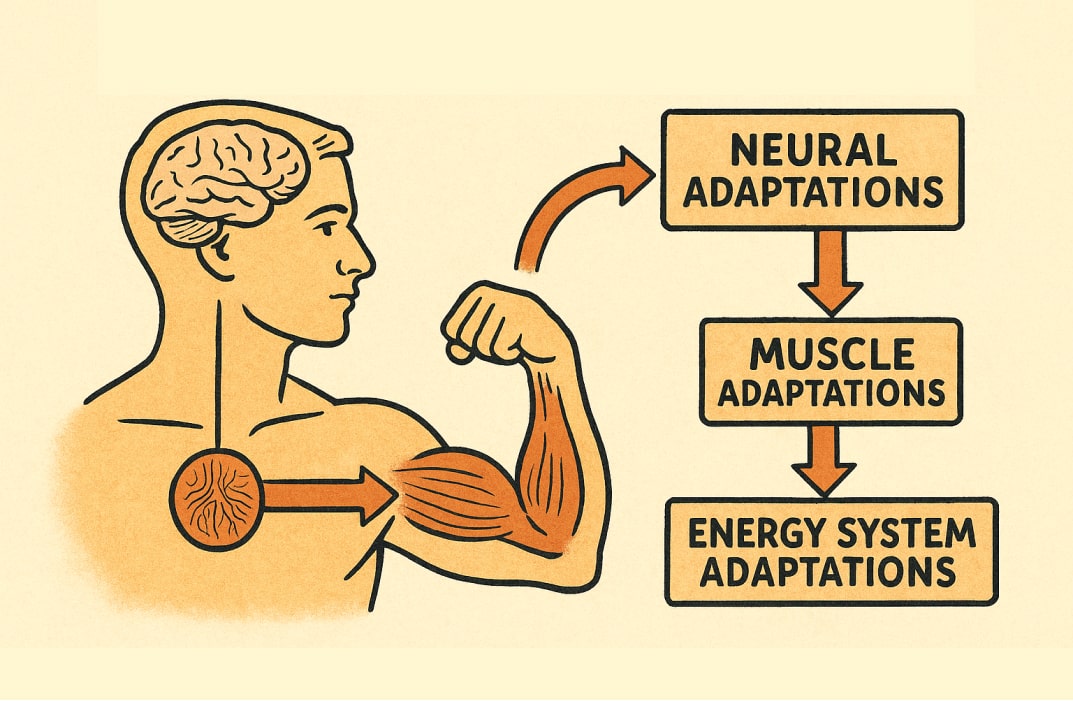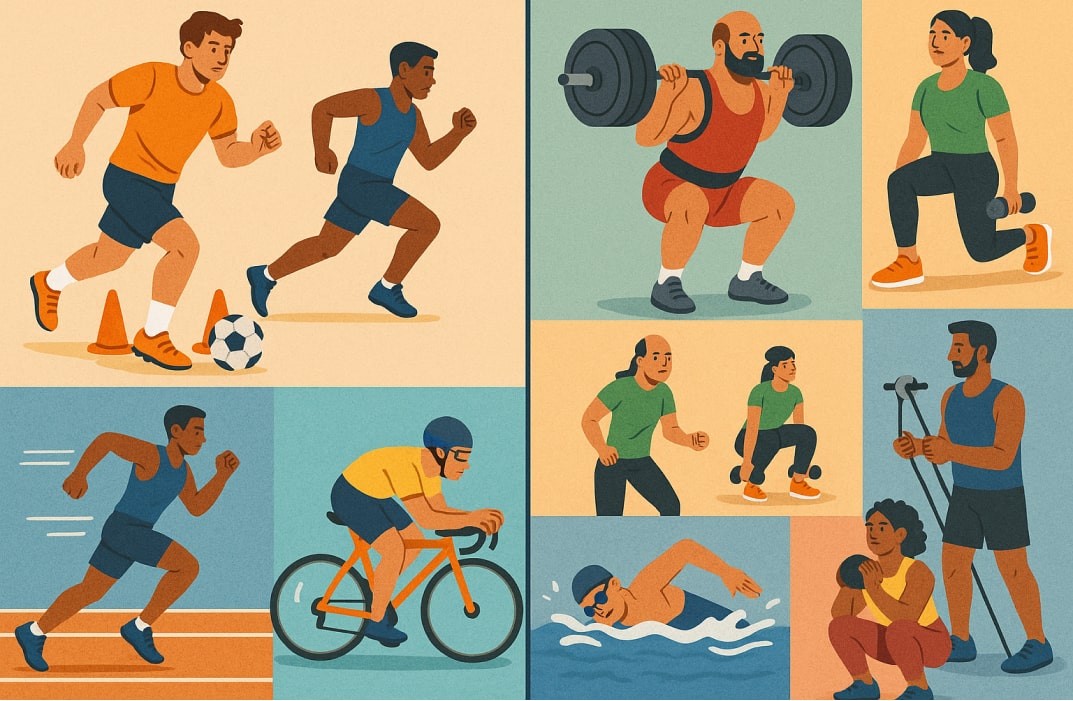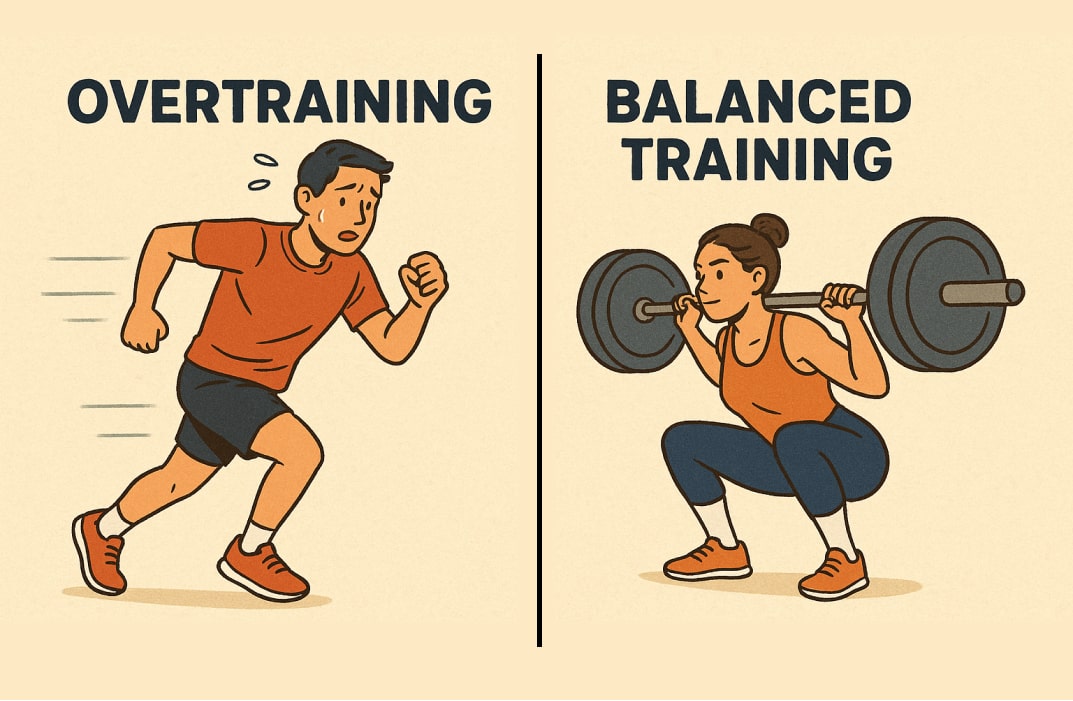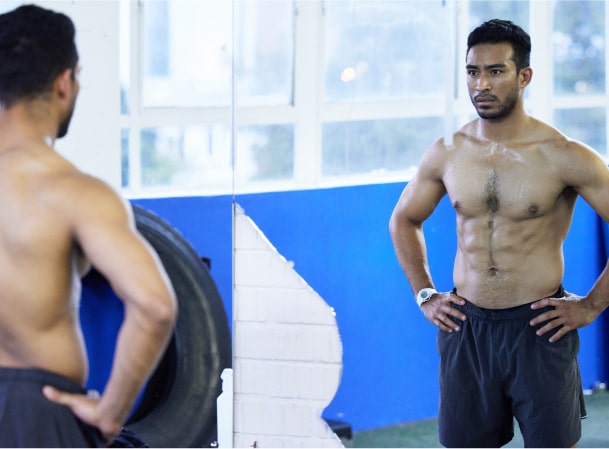Have you ever wondered why running five miles every day doesn’t necessarily make you a faster sprinter? Or why spending hours on the treadmill won’t help much when your goal is to lift heavier weights? The answer lies in one of the most important concepts in exercise science, the principle of specificity.
In simple terms, the specificity principle states that your body adapts to the specific type of training stress you put it through. If you train for endurance, you’ll improve stamina. If you focus on heavy lifting, you’ll develop strength. This is why athletes and fitness enthusiasts need to align their workouts closely with their goals.
Whether you’re a marathon runner training for race day, a soccer player working on agility drills, or someone just trying to improve general fitness, understanding and applying the specificity of training can make the difference between average results and outstanding progress.
In this blog, we’ll break down:
- What is the principle of specificity?
- How it applies differently to athletics and general fitness.
- Real-life examples of specificity training.
- The benefits, mistakes, and practical ways to apply this principle.
By the end, you’ll not only be able to define specificity in fitness, but also know how to use it to maximize performance, avoid wasted effort, and reach your fitness goals faster.
What is the Specificity Principle?

The specificity principle is one of the fundamental principles of training in exercise science. It means that the way you train should directly reflect the results you want to achieve. In other words: you get better at what you repeatedly practice.
If your goal is to increase strength, your program should emphasize resistance training with progressive overload. If your goal is to build endurance, your workouts should include longer, lower-intensity sessions that mimic the demands of your sport or activity. A swimmer, for instance, won’t see major performance gains from running alone — they need specific training in the pool to develop the right motor skills and muscle groups.
Key Definitions to Understand
- Specificity definition in fitness: Training adaptations occur when the body is exposed to specific movements, intensity, and stress that match the desired outcome.
- Principle of specificity of training: To improve in a particular activity, your workouts must mirror the skills, energy systems, and muscle actions used in that activity.
- Law of specificity: The body adapts to the exact type of physical activity and repetition range it experiences.
Backed by Science
Research consistently shows that training adaptations are highly specific:
- A 2019 study in the Journal of Strength and Conditioning Research found that athletes who trained with sport-specific drills improved performance 25–30% faster than those who did only general conditioning.
- Endurance athletes who added resistance training increased muscle strength by 8–12%, but their VO₂ max (a measure of aerobic capacity) improved very little — showing that strength gains don’t always translate into endurance improvements.
A Simple Example
- A marathon runner trains with long runs to prepare for race day, building stamina in the exact energy system they’ll use.
- A weightlifter focuses on low-rep, high-intensity lifts to gain strength and power.
- A soccer player practices short sprints and agility drills because these directly improve performance on the field.
This is why the specificity of training principle is so powerful: it ensures that every workout is aligned with your end goal, leading to more efficient progress and fewer wasted hours in the gym.
Science Behind Specificity: How the Body Adapts

The principle of specificity is not just a fitness slogan — it’s backed by exercise science and human physiology. Every time you train, your body responds to the training stress by making specific changes that prepare you for the exact type of activity you performed.
Neural Adaptations
In the early weeks of a strength training program, most improvements come from the nervous system. Your body learns to recruit more motor units (groups of muscle fibers activated by nerves), which leads to faster and more powerful contractions. This is why beginners often notice quick strength gains before they even build significant muscle.
Muscle Adaptations
Over time, the body adapts structurally too:
- Resistance training increases muscle fiber size (hypertrophy), particularly when training with the right repetition range and total volume.
- Endurance training, on the other hand, leads to more efficient eccentric contractions, improved blood flow, and greater oxygen delivery to working muscles.
- The size principle of motor unit recruitment ensures that as intensity increases, the body activates larger, more powerful muscle fibers.
Energy System Adaptations
Different sports rely on different energy systems. A marathon runner develops greater aerobic efficiency, while a sprinter builds explosive power by training the anaerobic system. Studies in Sports Science show that training in the wrong energy zone (e.g., long slow runs for a sprinter) produces minimal transfer to actual performance.
Why It Matters
This adaptation process is why a specific sport demands specific training. A cyclist won’t automatically become a strong swimmer, and a powerlifter won’t have marathon-level endurance. By targeting the right muscle groups, intensity, and movement patterns, athletes and fitness enthusiasts can ensure progress translates directly to their goals.
Why the Specificity Principle Matters in Training
When it comes to fitness, one of the biggest mistakes people make is following a random training plan that doesn’t match their actual goals. The principle of specificity ensures that every set, rep, and drill has a clear purpose.
1. Faster Progress Toward Goals
Because the body adapts to exactly what it practices, a specific training approach delivers results quicker than generalized workouts. For example, a study in Sports Science & Medicine reported that athletes who followed sport-specific training programs improved their performance by 20–25% more than those doing non-specific or general conditioning.
2. Strength and Endurance Gains Where They Matter
- Strength training with heavy loads builds force and power — essential for weightlifters, sprinters, and athletes in contact sports.
- Endurance-based training (long runs, cycling, swimming) improves the aerobic system, which is critical for a marathon runner or triathlete.
By matching the training style with the desired outcome, you avoid wasted effort and see strength gains or endurance improvements where you need them most.
3. Better Transfer to Real-Life or Sport Performance
The specificity of training is what makes a soccer player’s agility drills translate to sharper moves on the field, or a swimmer’s resistance band work lead to a faster stroke in the pool. It’s all about creating specific adaptations that mirror real-world movements.
4. Motivation and Consistency
Seeing measurable progress in the area you actually care about — whether it’s lifting more weight, running a faster mile, or simply improving general fitness — keeps motivation high. Training feels less like guesswork and more like a purpose-driven journey.
Specificity in Athletics

For athletes, the principle of specificity isn’t optional it’s the foundation of peak performance. Every drill, lift, and repetition is carefully designed to replicate the demands of their specific sport.
How Athletes Apply Specificity
- Sprinters train with short bursts of maximum speed and explosive strength training to enhance power and motor unit recruitment.
- Marathon runners focus on low-intensity, higher volumes, and long runs to condition their aerobic system and improve endurance for race day.
- Soccer players combine complex movements like agility drills, ball control, and sprint intervals that reflect the exact demands of the game.
- Swimmers practice in-water drills and resistance band pulls to mimic the eccentric phase of strokes.
- Weightlifters prioritize resistance training and low-repetition, high-intensity lifts for maximum strength gains.
Why This Matters
Athletes don’t have the luxury of training randomly — they must target the motor skills, muscle groups, and energy systems most relevant to their sport. According to Journal of Strength and Conditioning Research, specific training improved sport performance outcomes by over 30% compared to general conditioning programs.
The Takeaway
The specificity of training principle ensures that every session an athlete puts in brings them closer to the unique outcomes their sport requires — whether it’s more explosive speed, refined motor skills, or higher stamina.
Specificity in General Fitness
The principle of specificity isn’t just for elite athletes — it’s equally important for anyone working on their general fitness. Whether your goal is to lose weight, build strength, or improve cardiovascular endurance, your body adapts specifically to the type of training stress you apply.
How Specificity Works in General Fitness
- Want to get stronger? Focus on resistance training (like squats, bench presses, or push-ups) in lower repetition ranges with progressive overload.
- Want to improve endurance? Structure workouts with longer sessions, lighter loads, and more repetitions to target aerobic development.
- Want to lose fat? Combine physical activity like high-intensity interval training (HIIT) with strength training to maximize calorie burn and muscle retention.
- Want better mobility? Prioritize specific movements such as stretching, yoga, or dynamic drills that directly improve flexibility.
Real-World Example
If your goal is to run a 5K, jogging on a treadmill will help, but practicing actual outdoor running on varied terrain will prepare you far better for race day conditions. The body adapts to the environment and specific adaptations happen when you practice what you want to perform.
Why It Matters
Without applying specificity, you risk spending hours in the gym without moving closer to your actual goals. A training plan that matches your objective — whether it’s strength gains, fat loss, or endurance — ensures you see substantial improvements in performance and body composition.
Athletics vs. General Fitness: How Specificity Differs
The specificity principle applies to both athletes and everyday fitness enthusiasts, but the way it’s used differs depending on the end goal. Athletes aim for peak performance in a specific sport, while general fitness followers aim for overall health, strength, or aesthetic improvements.
Key Differences
- Athletics: Training revolves around fine-tuning motor skills, energy systems, and sport-specific movements to maximize performance.
- General Fitness: Training focuses on building a foundation of strength, endurance, mobility, and overall health through broader movement patterns.
Side-by-Side Comparison
The Takeaway
While both groups follow the training principle of specificity, athletes fine-tune for performance in competition, while everyday people apply it to improve quality of life. Both approaches rely on the same fundamental principle: the body adapts to exactly what you train it for.
Practical Tips to Apply Specificity in Your Training
Understanding the principle of specificity is one thing, but applying it effectively to your own training plan is where results really show up. Here are some practical ways to make your workouts more goal-focused and efficient:
1. Define Your Goal Clearly
Ask yourself: Do I want to build strength, improve endurance, or train for a specific sport? Your training should reflect this. For example:
- Strength gains → focus on resistance training with low repetition ranges and heavy loads.
- Endurance → prioritize longer sessions with lighter weights and higher volumes.
- Fat loss / General fitness → use a mix of strength and conditioning sessions.
2. Match Training to Movement Patterns
If you want to get better at a specific activity, mimic its specific movements:
- Runners → running drills, hill sprints, interval training.
- Cyclists → cycling at different intensities and terrains.
- General fitness → compound lifts (squats, push-ups, pull-ups) for overall development.
3. Adjust Intensity and Volume
Your body adapts to the load you put on it. For faster improvement, tweak:
- Repetition range → lower reps for strength, higher reps for endurance.
- Intensity → increase weight, speed, or duration gradually.
- Total volume → balance frequency and sets per week based on recovery needs.
4. Plan for Progress
A good training plan includes steady progression. Track performance metrics like time, distance, weight lifted, or reps to ensure you’re moving toward your goal.
5. Work with a Personal Trainer (Optional)
If you’re unsure how to apply the training principle of specificity, a personal trainer can design a program tailored to your sport, fitness level, and lifestyle.
Examples of Specificity Exercises

The specificity of training principle means your workouts should mimic the demands of your goal. Research consistently shows that when training directly aligns with your performance needs, results improve dramatically.
- A study in the Journal of Strength and Conditioning Research found that athletes who followed sport-specific training programs saw a 30% increase in performance outcomes compared to those doing only general conditioning.
- According to Human Kinetics, even recreational exercisers improved endurance by 20% more when they trained with goal-specific workouts versus random fitness routines.
Here’s how specificity looks in practice:
A. Sports-Specific Training Examples
- Sprinters → Short sprints, resisted sled pushes, plyometric jumps.
- Data: Explosive drills like plyometrics can improve sprint performance by 5–8% within 6 weeks.
- Soccer Players → Agility ladder drills, shuttle runs, ball-control work.
- Data: Soccer players who incorporated agility drills improved change-of-direction speed by up to 10%.
- Marathon Runners → Long runs at low intensity, tempo runs, and interval sessions.
- Data: Specific marathon training improved VO₂ max and endurance capacity by 15–20% in trained runners.
- Swimmers → Pool sprints, resistance band pulls mimicking strokes, eccentric contractions.
- Data: Resistance-based swim drills increased stroke efficiency by 12%.
- Weightlifters → Heavy squats, deadlifts, and bench presses at low repetition ranges.
- Data: Targeted resistance training produces greater strength gains (20–25%) than mixed, non-specific workouts.
B. General Fitness Training Examples
- Strength & Muscle Development → Squats, lunges, push-ups, pull-ups.
- Data: Resistance training 3x per week improves strength by 25–30% in beginners within 12 weeks.
- Endurance & Fat Loss → Circuit workouts, rowing, HIIT with resistance training.
- Data: HIIT can burn 25–30% more calories than steady-state cardio in the same time frame.
- Mobility & Flexibility → Yoga, dynamic stretching, mobility drills.
- Data: Regular mobility training can reduce injury risk by 15–20% in recreational athletes.
- Improved Daily Performance → Functional moves like farmer’s carries, kettlebell swings.
- Data: Functional training improves balance and coordination by up to 18%, enhancing real-world movement efficiency.
Why These Work
Each exercise directly matches the specific adaptations your body needs for the desired outcome. By practicing movements similar to your sport or fitness goal, you improve motor units, skills, and overall performance much faster than with random, generalized workouts.
Benefits of Applying Specificity
Applying the principle of specificity in your training isn’t just smart — it’s essential for maximizing results. Whether you’re an athlete or working on general fitness, targeting your workouts to match your goals offers several clear benefits:
1. Faster, Measurable Progress
Training specifically ensures the body adapts directly to the demands you place on it. Studies show that athletes following goal-specific programs improve performance 20–30% faster than those doing generalized routines.
2. Enhanced Strength and Endurance
- Strength gains: Targeted resistance training produces larger improvements in maximal force compared to random exercise.
- Endurance improvements: Long, goal-specific sessions increase VO₂ max and stamina by 15–20% in recreational runners or cyclists within 8–12 weeks.
3. Better Skill Development
Specific training enhances motor skills and movement efficiency. For example, soccer players practicing agility drills improve change-of-direction speed by up to 10%, while swimmers see up to 12% improvement in stroke efficiency with targeted resistance-based drills.
4. Reduced Risk of Injury
By focusing on the movements and muscle groups you actually need, you avoid overworking irrelevant muscles or joints. This not only protects your body but also ensures longevity in your sport or fitness journey.
5. Improved Motivation and Consistency
Seeing tangible results in the area you care about — whether lifting heavier weights, running faster, or improving daily performance keeps motivation high. Specific workouts give a purpose-driven feel, making consistency easier.
Common Mistakes & Misconceptions

Even with a solid understanding of the principle of specificity, many people unintentionally limit their results by making simple mistakes.
1. Over-Specialization Too Early
Focusing solely on one specific skill or movement without building a general fitness foundation can lead to imbalances and injuries. For example, a beginner soccer player doing only sprint drills may neglect strength training needed for joint stability.
2. Ignoring General Conditioning
While specificity is key, completely ignoring general fitness can hurt long-term performance. Strength, endurance, and mobility are the building blocks that allow specific adaptations to be more effective.
3. Copying Elite Athlete Workouts
Just because a professional sprinter or weightlifter follows a certain routine doesn’t mean it’s suitable for you. Training must match your goals, fitness level, and recovery capacity.
4. Neglecting Proper Intensity and Volume
Specificity works only when the training stress is applied correctly. Too little intensity or too short a time frame may produce minimal results, while excessive load can increase injury risk.
5. Skipping Progression Tracking
Without monitoring performance metrics, it’s hard to know if your specific training is effective. Tracking strength, endurance, or skill performance ensures continual progress and helps adjust your training plan when needed.
How FitBudd Helps You Apply the Specificity Principle
Applying the specificity principle can be challenging without a clear plan—but FitBudd empowers trainers and coaches to design programs that target the right specificity states for each client. Whether the goal is sport performance or general fitness, FitBudd provides the tools to create purposeful, goal-oriented training.
Trainers can:
- Design personalized programs: Tailor routines to a client’s sport, fitness level, or lifestyle, incorporating strength, endurance, and skill-specific exercises.
- Track progress and adjust: Monitor performance metrics to ensure specific goals are being met and fine-tune training as needed.
- Leverage expert insights: Use principles from human kinetics and certified trainer guidance to ensure every session is science-based and effective.
With FitBudd, coaches can make each session meaningful, helping clients achieve substantial gains, save time, and improve overall performance by applying the specificity principle systematically.
Conclusion

The principle of specificity is one of the most powerful concepts in both athletics and general fitness. Whether your goal is to improve strength, endurance, or sport-specific skills, your body adapts only to the type of stress you consistently apply.
By aligning your training plan with your goals, you can:
- Achieve faster and measurable progress.
- Develop strength, endurance, and skills where it matters most.
- Reduce the risk of injury by targeting the right muscle groups and movements.
- Stay motivated through purpose-driven workouts that produce tangible results.
Remember, the same principle applies whether you’re a marathon runner preparing for race day, a soccer player refining agility, or someone improving general fitness. Train specifically, track your progress, and your workouts will translate into real-world results.
By embracing the specificity of training principle, you ensure every session counts, making your fitness journey more efficient, effective, and rewarding.
92% trainers worldwide gave us 5 stars
Talk to your dedicated success manager and launch your branded fitness app during the demo in minutes.
Start your paid subscription for $79 FREE





%20to%20Become%20a%20Certified%20Personal%20Trainer-min.jpg)





